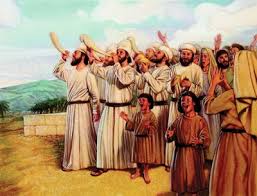The Rest of the Levites
First Chronicles 24: 20-31
The rest of the Levites DIG: Why do you suppose the chronicler was so concerned that no one should feel excluded, and even repeated the lists within the same book? Where have you seen these names before? How many generations separate Amram from Shubael? Who was Shubael’s famous grandfather? Was Eleazar childless? Why is he listed next to Kish? What means is again used to ensure fairness and minimize power plays and party politics? Why all the witnesses?
REFLECT: By what means does your messianic synagogue or church distribute privileges or chores “evenly” among the congregation?
David started making the arrangements for Temple services
several years before the end of his life.

The original purpose of the list was probably to update the previous one. As for the rest of the descendants of Levi, the bulk of whom were not descendants of Aaron, and therefore, not priests. They were divided into ministering groups and assisted the priests in the ministry of the Temple.
First the chronicler listed the line of the Kohathites. There were nine divisions that arose from Levi’s second son Kohath through his four sons:
From the descendants of Amram: Shubael; from the sons of Shubael: Jehdeiah (First Chronicles 24:20). As for Rehabiah, from his sons: Ishiah served as the division leader (First Chronicles 24:21).
From the descendants of Izharites: Shelomoth; from the sons of Shelomoth: Jahath (First Chronicles 24:22).
The descendants of Hebron: Jeriah the first, Amariah the second, Jahaziel the third and Jekameam the fourth (First Chronicles 24:23).
The descendants of Uzziel: Micah; from the sons of Micah: Shamir (First Chronicles 24:24). The brother of Micah: Ishiah; from the sons of Ishiah: Zechariah (First Chronicles 24:25).
The chronicler next listed four divisions from the line of the Merarites. There were now seven divisions that arose from Levi’s third son Merari. Originally the two sons of Merari were Mahli and Mushil.
From the descendants of Mahli: Eleazar, who had no sons, only daughters. From Kish: the son of Kish: Jerahmeel served as the division leader, representing in David’s day the Mahlite group of Eleazar and Kish, which had been consolidated into one (First Chronicles 24:28-29).
And the descendants of Mushi: another descendant named Mahli, Eder and Jerimoth (First Chronicles 24:30a).
An interesting phenomenon is exhibited in the list of the Merarites. Contrary to all other Levitical genealogies, both in the Pentateuch and Chronicles, Merari is depicted as having a third son, Jaaziah. It should be clear that the phenomenon couldn’t be explained in mere biological terms. It is hardly possible that a new “son” had suddenly been born to Merari. We can only conclude that in the interval between the first list (see Eu – The Merarites) and this one was that the structure of the Merarites had undergone far-reaching changes, and perhaps the house of Jaaziah was chosen as a “son” to replace the house of Eleazar who bore no sons. Therefore, the house of Eleazar, son of Mahli, was completely abolished; the house of Mushi remained unchanged, but three new houses were established.529 The sons of Jaaziah his “son” (Hebrew: beno meaning his son) – that is, the descendants of Merari belonging to Jaaziah his “son” were Shoham, Zakkur and Ibri (First Chronicles 24:26-27, the Ellicott’s Commentary for English Readers).
Although not listed for some unknown reason, one may conjecture that the missing Gershonites composed the remaining eight divisions, bringing the total to twenty-four. There were twenty-four divisions of Levites, the descendants of Levi, just as there were twenty-four divisions of priests, the descendants of Aaron.
These were the Levites, according to their families (First Chronicles 24:30b). They also cast lots (see the commentary on Exodus, to see link click Gb – The Urim and Thummim: The Means of Making Decisions), just as their relatives the descendants of Aaron did, in the presence of King David and of Zadok, Ahimelek, and the heads of families of the priests and of the Levites. The families of the oldest brother were treated the same as those of the youngest (First Chronicles 24:31).



Leave A Comment